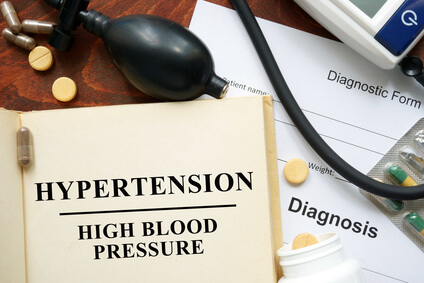The decision to be made with a treatment-free patient with systolic blood pressure over 160 mmHg or diastolic blood pressure over 100 mmHg is an easy one. All guidelines agree: treatment should be started immediately alongside lifestyle changes.
 In the case of patients with systolic blood pressure between 140 and 159 mmHg or diastolic blood pressure between 90 and 99 mmHg, the 2018 European guidelines are more liberal, recommending pharmacological treatment plus lifestyle changes for all patients, including those with low-to-moderate cardiovascular risk. Again, the choice here is easy and such recommendations match those featured in the 2017 American College of Cardiology/American Heart Association (ACC/AHA) guidelines.
In the case of patients with systolic blood pressure between 140 and 159 mmHg or diastolic blood pressure between 90 and 99 mmHg, the 2018 European guidelines are more liberal, recommending pharmacological treatment plus lifestyle changes for all patients, including those with low-to-moderate cardiovascular risk. Again, the choice here is easy and such recommendations match those featured in the 2017 American College of Cardiology/American Heart Association (ACC/AHA) guidelines.
Taking into account all that has been mentioned, we could conclude that both sides of the Atlantic Ocean agree on how to manage patients with levels over 140/90, regardless of their global cardiovascular risk.
Read also: TAVR Post-dilation Is Safe.
However, this is medicine, and not everything is black and white: there are patients with levels between 130/80 and 139/89, and they constitute a significant, heterogeneous part of the population. Regarding them, the agreement among guidelines from different scientific societies comes to a halt. Now, if the experts could not reach an agreement, what is left for a clinical cardiologist who works alone in his/her practice?
This lack of agreement is noticeable even in the definition of these patients. For Americans, patients with levels between 120/80 and 139/89 are defined as “pre-hypertensive,” which is a way to emphasize their high risk of developing this disease. Controversially, both Europeans and Canadians catalogue these as “high normal” values, thus emphasizing that these figures do not entail hypertension.
In 2017, the ACC/AHA adopted a radical strategy, changing the “pre-hypertension” category for grade 1 hypertension. This decision was based on several studies that showed a higher risk of stroke and coronary disease in patients with levels <120/80.
Beyond definitions, the million-dollar question is whether patients with levels between 130/80 and 139/89 should start pharmacological treatment. Unfortunately, there are no placebo-controlled randomized studies for this population, and guidelines were ultimately based on either observational studies or meta-analyses.
The 2017 American guidelines clearly recommend pharmacological treatment plus lifestyle changes for this population if at least one of the following conditions is met: diabetes, chronic kidney disease, history of vascular disease, ≥10% 10-year risk, or age ≥65 years.
Europeans think differently: pharmacological treatment “might be considered” with presence of established vascular disease or in patients whose levels are around 140/90, including those with low or moderate cardiovascular risk. In patients with diabetes, pharmacological treatment is recommended only in the presence of levels above 140/90 and with a moderate target (lower than 130 mmHg, instead of lower than 120 mmHg, which was suggested by Americans).
Dr. Colantonio presented an analysis of the REGARDS (REasons for Geographic And Racial Differences in Stroke) study, in which patients were classified according to the 2017 ACC/AHA guidelines (<130/80, 130/80 to 139/89, and >140/90). Patients were grouped according to treatment absence or presence at the time of enrollment, presence or absence of clinical conditions marking the start of treatment, and whether treatment was started or intensified according to the aforementioned guidelines.
The most interesting aspect of this study was, of course, the analysis of patients with levels between 130/80 and 139/89, who did not receive pharmacological treatment.
For this group, the rate of cardiovascular events and mortality was 6 times higher than for those treated according to the American guidelines. Events were also higher for patients in this group, but their treatment was not intensified to reach guideline-recommended optimal values.
Read also: Debris Captured by SENTINEL Devices Result Different across Different Valves.
Dr. Colantonio’s study is important because it supports the ACC/AHA position, despite several limitations, such as a lack of information regarding treatment start or intensification, or tolerance to treatment during follow-up. Many patients could have started treatment at different follow-up times, thus affecting the results. Additionally, the cardiovascular risk was higher than it had been estimated at the beginning of this study.
Finally, Dr. Colantonio’s study also supports European guidelines in their recommendation to start pharmacological treatment in at least some individuals with levels between 130/80 and 139/89 mmHg.
Future studies must clarify the cost-benefit analysis of treating or intensifying treatment in this intermediate patient group whom we frequently encounter in clinical practice.
Original title: What to Do When Blood Pressure Is Between 130/80 and 139/89 mmHg?
Reference: Paolo Verdecchia et al. J Am Coll Cardiol. 2018 Sep 11;72(11):1198-1200.
Get the latest scientific articles on interventional cardiologySubscribe to our weekly newsletter
We are interested in your opinion. Please, leave your comments, thoughts, questions, etc., below. They will be most welcome.





